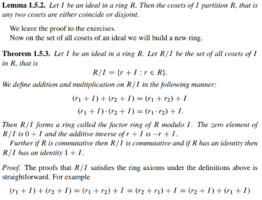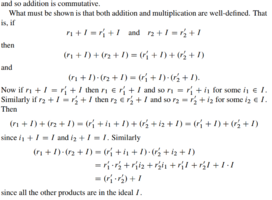I am studying the abstract algebra with abstract algebra applications to galois theory, algebraic geometry and cryptography-Celine Carstensen, Benjamin Fine, Gerhard Rosenberger. At page 10, I couldn't understand from Lemma 1.5.2 to Theorem 1.5.3. (I will wirte it below.) Because I think that the subring is sufficient to satisfy same Lemma. coset of subring partion R. I will prove it and if my proof have some error, please teach me why it is wrong and how can I fix it. here is the proof.
first, cosets can make R by union. Let s is element of subring S. Then superring R has s too. And R also has -s by Axiom of ring(ring has additive inverse). So there is coset(-s+S) that have 0. And ring is closed by addition. So r-s is element of R for every r which is element of R. Then coset((r-s)+S) have r. So every element of R is also element of some coset. Then we can make R with cosets by union.
Second, Any two cosets are either coincide or disjoint. There are three relation that cosets can have. one is coincide, another is disjoint, the other is there exist same element not for all. So if I prove that if there is same element between cosets, the two cosets are the same, it means that Any two cosets are either coincide or disjoint. If there is same element that is s_1+r_1=s_2+r_2, r_1-r_2=s_2-s_1 is element of S by axiom of ring(ring is closed by additive inverse). So there is s+r_1-r_2 in S and there is s+r1 in C_2(r_2+S) for all element s of S. Likewise, s+r_2 is in C_1(r_1+S). It states that C_1 is subset of C_2 and C_2 is subset of C_1. Then C_1 equals C_2. Q.E.D
And I have second question about (r'_1+i_1+I)*(r'_2+i_2+I)=r'_1r'_2+r'_1i_2+r'_2i_1+r'_1I+r'_2I+II in final part of below proof. I couldn't understand why (r'_1+i_1+I)*(r'_2+i_2+I) is equals to r'_1r'_2+r'_1i_2+r'_2i_1+r'_1I+r'_2I+II and how we can see that the ideal property is necessary In here.
So I made a proof of it. The * was defined as (r_1+I)*(r_2+I)=(r_1r_2)+I. So I think that (r'_1+i_1+I)*(r'_2+i_2+I)=(r'_1r'_2+r'_1i_2+r'_2i_1+i_1i_2)+I. Then ,by the definition of addition, It can be rewrite as (r'_1r'_2+I)+(r'_1i_2+I)+(r'_2i_1+I)+(i_1i_2+I). Then because I is ideal, (r'_1i_2+I)+(r'_2i_1+I)+(i_1i_2+I)=I. So (r'_1r'_2+I)+(r'_1i_2+I)+(r'_2i_1+I)+(i_1i_2+I)=(r'_1r'_2+I)+I=(r'_1r'_2+I). And, In this part, we can see why the ideal property is necessary.
Please tell me why the proof in the book is diffrent with my proof and what is diffrence too.
# I am the beginner of math So It is first time that I ask my question in the Forum. So I am awkward in posting. So I don't know how can expess the question in posting. If I miss some information, please let me know that what information is needed.



first, cosets can make R by union. Let s is element of subring S. Then superring R has s too. And R also has -s by Axiom of ring(ring has additive inverse). So there is coset(-s+S) that have 0. And ring is closed by addition. So r-s is element of R for every r which is element of R. Then coset((r-s)+S) have r. So every element of R is also element of some coset. Then we can make R with cosets by union.
Second, Any two cosets are either coincide or disjoint. There are three relation that cosets can have. one is coincide, another is disjoint, the other is there exist same element not for all. So if I prove that if there is same element between cosets, the two cosets are the same, it means that Any two cosets are either coincide or disjoint. If there is same element that is s_1+r_1=s_2+r_2, r_1-r_2=s_2-s_1 is element of S by axiom of ring(ring is closed by additive inverse). So there is s+r_1-r_2 in S and there is s+r1 in C_2(r_2+S) for all element s of S. Likewise, s+r_2 is in C_1(r_1+S). It states that C_1 is subset of C_2 and C_2 is subset of C_1. Then C_1 equals C_2. Q.E.D
And I have second question about (r'_1+i_1+I)*(r'_2+i_2+I)=r'_1r'_2+r'_1i_2+r'_2i_1+r'_1I+r'_2I+II in final part of below proof. I couldn't understand why (r'_1+i_1+I)*(r'_2+i_2+I) is equals to r'_1r'_2+r'_1i_2+r'_2i_1+r'_1I+r'_2I+II and how we can see that the ideal property is necessary In here.
So I made a proof of it. The * was defined as (r_1+I)*(r_2+I)=(r_1r_2)+I. So I think that (r'_1+i_1+I)*(r'_2+i_2+I)=(r'_1r'_2+r'_1i_2+r'_2i_1+i_1i_2)+I. Then ,by the definition of addition, It can be rewrite as (r'_1r'_2+I)+(r'_1i_2+I)+(r'_2i_1+I)+(i_1i_2+I). Then because I is ideal, (r'_1i_2+I)+(r'_2i_1+I)+(i_1i_2+I)=I. So (r'_1r'_2+I)+(r'_1i_2+I)+(r'_2i_1+I)+(i_1i_2+I)=(r'_1r'_2+I)+I=(r'_1r'_2+I). And, In this part, we can see why the ideal property is necessary.
Please tell me why the proof in the book is diffrent with my proof and what is diffrence too.
# I am the beginner of math So It is first time that I ask my question in the Forum. So I am awkward in posting. So I don't know how can expess the question in posting. If I miss some information, please let me know that what information is needed.



